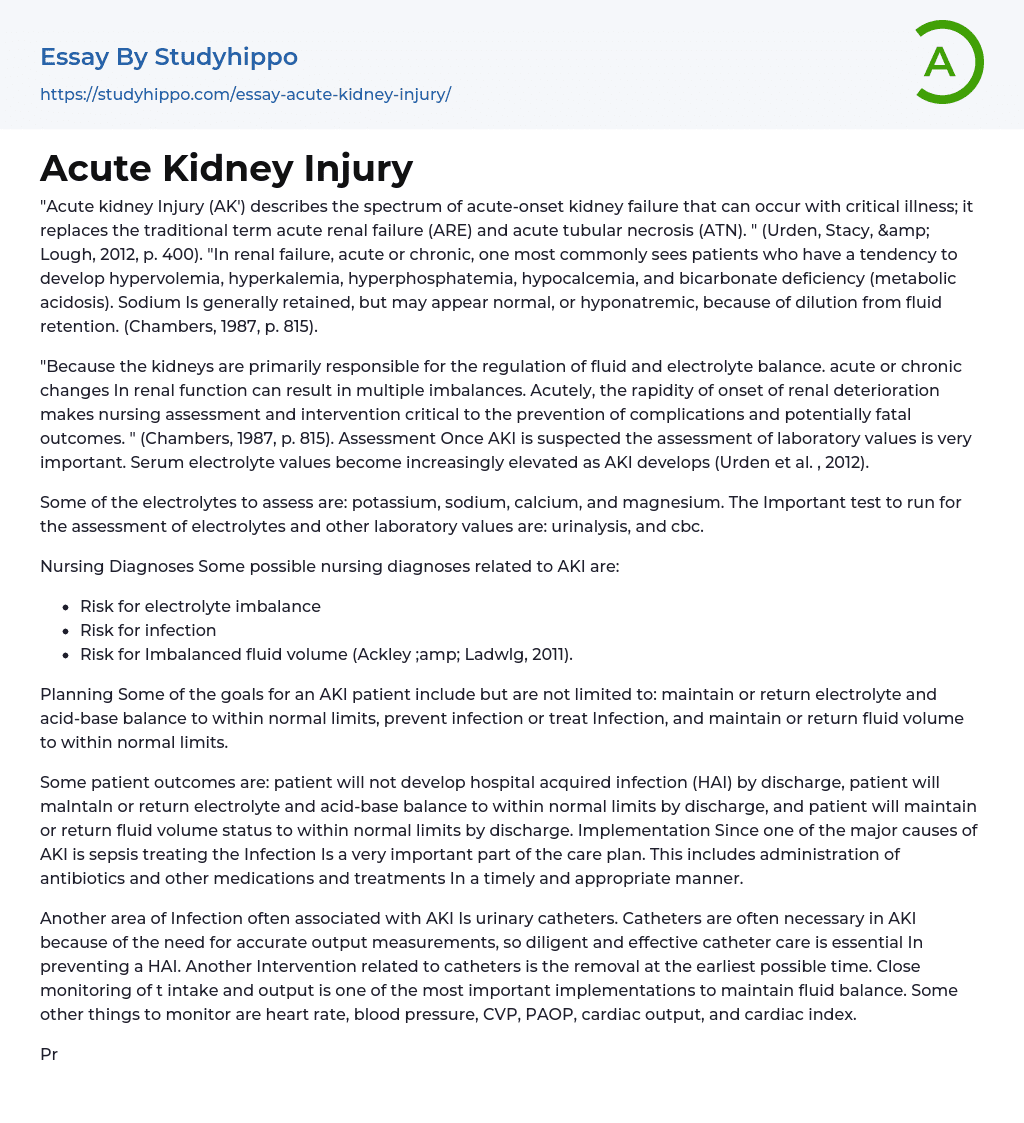"Acute kidney Injury (AK') describes the spectrum of acute-onset kidney failure that can occur with critical illness; it replaces the traditional term acute renal failure (ARE) and acute tubular necrosis (ATN). " (Urden, Stacy, & Lough, 2012, p. 400). "In renal failure, acute or chronic, one most commonly sees patients who have a tendency to develop hypervolemia, hyperkalemia, hyperphosphatemia, hypocalcemia, and bicarbonate deficiency (metabolic acidosis). Sodium Is generally retained, but may appear normal, or hyponatremic, because of dilution from fluid retention. (Chambers, 1987, p. 815).
"Because the kidneys are primarily responsible for the regulation of fluid and electrolyte balance. acute or chronic changes In renal function can result in multiple imbalances. Acutely, the rapidity of onset of renal deterioration makes nursing assessment and intervention critical to the prevention of complications and potentially fatal outcomes. " (Chambers, 1987, p. 815). Assessment O
...nce AKI is suspected the assessment of laboratory values is very important. Serum electrolyte values become increasingly elevated as AKI develops (Urden et al. , 2012).
Some of the electrolytes to assess are: potassium, sodium, calcium, and magnesium. The Important test to run for the assessment of electrolytes and other laboratory values are: urinalysis, and cbc.
Nursing Diagnoses Some possible nursing diagnoses related to AKI are:
- Risk for electrolyte imbalance
- Risk for infection
- Risk for Imbalanced fluid volume (Ackley ;amp; Ladwlg, 2011).
Planning Some of the goals for an AKI patient include but are not limited to: maintain or return electrolyte and acid-base balance to within normal limits, prevent infection or treat Infection, and maintain or return fluid volume to within normal limits.
Some patient outcomes are: patient will not develop hospital acquired infection (HAI) by discharge, patient will malntaln
or return electrolyte and acid-base balance to within normal limits by discharge, and patient will maintain or return fluid volume status to within normal limits by discharge. Implementation Since one of the major causes of AKI is sepsis treating the Infection Is a very important part of the care plan. This includes administration of antibiotics and other medications and treatments In a timely and appropriate manner.
Another area of Infection often associated with AKI Is urinary catheters. Catheters are often necessary in AKI because of the need for accurate output measurements, so diligent and effective catheter care is essential In preventing a HAI. Another Intervention related to catheters is the removal at the earliest possible time. Close monitoring of t intake and output is one of the most important implementations to maintain fluid balance. Some other things to monitor are heart rate, blood pressure, CVP, PAOP, cardiac output, and cardiac index.
Preventing severe electrolyte and acid-base balance disturbances is accomplished by closely monitoring laboratory values. Hyperkalemia and hypocalcemia can result in life-threatening cardiac dysrhythmias, hyponatremia can result in fluid overload, and hyperphosphatemia results in severe pruritus. Electrolytes are often replaced by IV fluids but some nursing interventions to treat hyperphosphatemia are: frequent skin care with emollients to prevent itching, discouraging scratching, and administering phosphate-binding medications (Urden et al. 2012).
Evaluation The laboratory values will determine the effectiveness of the interventions implemented by the nurse. If the patient's electrolytes and acid-base levels are within normal limits the interventions were successful. If the patient doesn't develop a HAI the interventions have worked. Intake and output, daily weight measurements, and hemodynamic values (heart rate, blood pressure, CVP, PAOP, cardiac output, and
cardiac index) determine the status of fluid volume overload.
Conclusion The nurse is the patient's first line of defense against many of the complications AK'. The nurse monitors the laboratory values and notifies the physician of any abnormal values to obtain orders to give medications and IV fluids to correct imbalances. If the nurse is not monitoring these laboratory values closely enough it can be life- threatening for the patient. An alert and responsible nurse is the patient's best defense against complications of AK'.
- Cloning essays
- Medical Ethics essays
- Patient essays
- Therapy essays
- drugs essays
- Cannabis essays
- Aspirin essays
- Cardiology essays
- Hemoglobin essays
- Pharmacology essays
- Surgery essays
- alternative medicine essays
- Plastic Surgery essays
- Organ Donation essays
- Vaccines essays
- Medical essays
- Dentist essays
- Psychological Trauma essays
- Physical therapy essays
- Cold essays
- Cocaine essays
- Why Marijuana Should Be Legalized essays
- Drug Abuse essays
- Teenage Drug Abuse essays
- Heart Disease essays
- Artery essays
- Action Potential essays
- Blood essays
- Body essays
- Brain essays
- Childbirth essays
- Eye essays
- Glucose essays
- Heart essays
- Human Physiology essays
- Immune System essays
- Kidney essays
- Muscle essays
- Nervous System essays
- Neuron essays
- Poison essays
- Puberty essays
- Sense essays
- Skeleton essays
- Skin essays
- Addiction essays
- Anatomy and Physiology essays
- Biodegradation essays
- Cancer essays
- Dental Care essays




